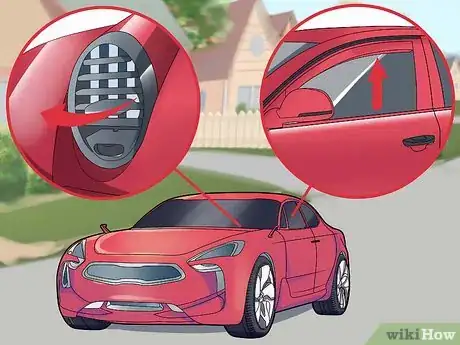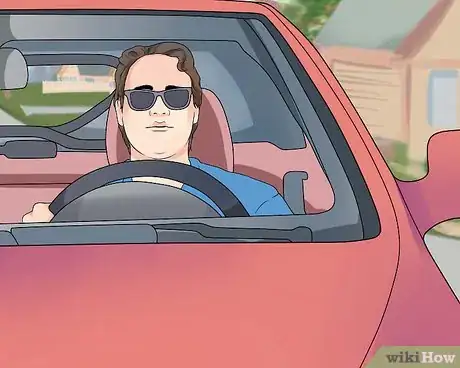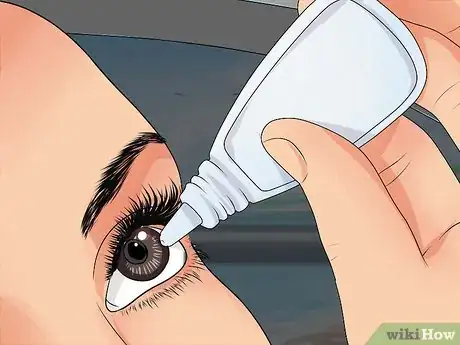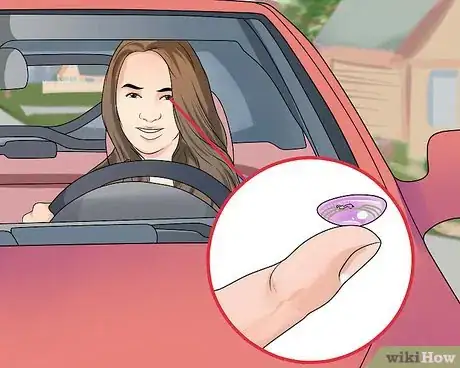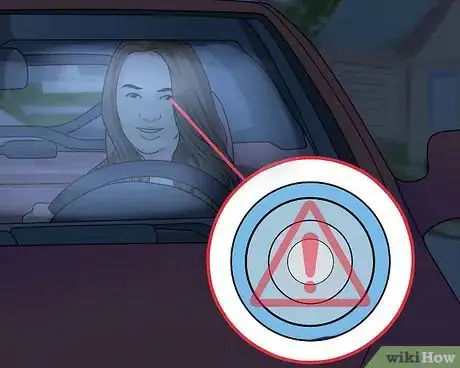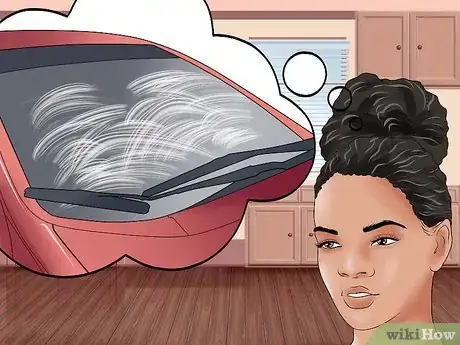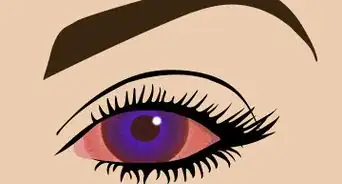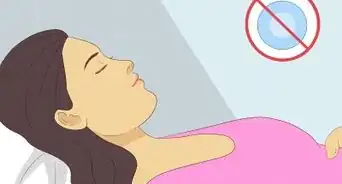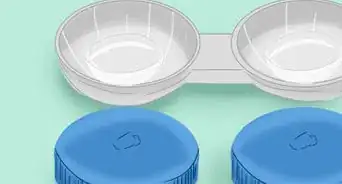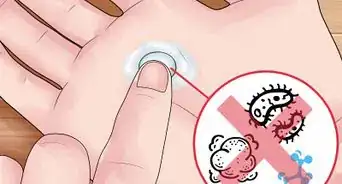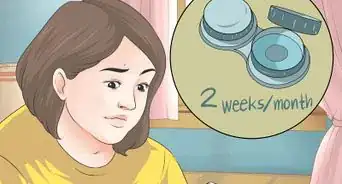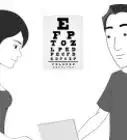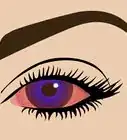This article was medically reviewed by Shaune Wallace, OD and by wikiHow staff writer, Christopher M. Osborne, PhD. Dr. Wallace is an Optometrist in Nevada with over 14 years of optometry experience. He received his OD from the Southern California College of Optometry in 2006 and is a member of the American Optometric Association.
There are 9 references cited in this article, which can be found at the bottom of the page.
This article has been viewed 51,952 times.
If you wear contact lenses for vision correction, you should always wear them (or eyeglasses) when driving an automobile; however, some types of contacts are better suited to driving than others, especially at night. Also, moving air from vents or open windows can cause contact dryness, discomfort, and possibly blurred vision. Being informed about your lenses and making common-sense adjustments can usually make driving with contacts no problem.
Steps
Preventing Discomfort
-
1Redirect air vents and close the driver's side window. If your contacts and eyes tend to get dry or uncomfortable while driving, excessive airflow over the contacts may be the culprit.[1]
- Simply reducing airflow into your face may be all it takes to limit this problem. Keep moving air from vents and open windows away from your eyes.
- If your eyes get itchy, this may be a sign of allergies. This may be better treated with an allergy drop like Zaditor.[2]
-
2Cover your eyes while driving. No, of course this does not mean to drive blindfolded or play “peek-a-boo” with the surrounding traffic! Rather, the goal is to block airflow from passing over and drying the contacts without impairing vision.[3] During the daytime, this effect can be achieved by wearing sunglasses. Consider polarized lenses to reduce glare.
- Sunglasses don't work so well at night, obviously, but you could try clear plastic safety glasses if you're more concerned with comfort than fashion. Goggles are probably going too far, and may limit your peripheral vision anyway.
- The vision benefits of non-prescription night-driving glasses are debatable, but they will help reduce airflow.[4]
Advertisement -
3Use lubricating drops. Whenever your eyes start to feel dried out, use eye drops approved by your eye doctor for use with your contacts. Make sure that the eye drops you are using are safe for contact lenses.[5]
- Don't try to put drops in your eyes while driving! Pull over for a minute.
- While on the subject, never try to adjust, fix, or find a wayward contact while driving. Always stop to make necessary adjustments, and have a backup pair of contacts or glasses handy.
-
4Try alternate types of contacts. Contacts today generally come in either the soft or rigid gas permeable (RGP) varieties. Several companies produce multiple types of each. No single type or brand is clearly better at preventing dry eyes while driving, so you may need to undertake a trial-and-error process.[6]
- Consult with your eye care professional about trying a different lens type or brand. You can also consider options like glasses or surgery, depending on your vision needs.[7] Ask about new "water gradient" lenses, which claim to be more comfortable and better for dry eyes.[8]
- If your contacts improve your vision but are not consistently comfortable, the benefits will be significantly reduced. Clarity and comfort are both important when you are behind the wheel.
Maintaining Clear Vision
-
1Drive with contacts as recommended and required. Always follow your prescribing eye doctor's advice about when to wear your contacts (or other corrective lenses). If she says to wear them all the time, or always when driving, do so.
- If you need corrective eyewear to see clearly, you will likely be required by law to wear them when driving. Otherwise, your driving privileges could be suspended.
- Some people worry that monovision contacts — where the contact in the dominant eye is calibrated for distant objects, and the weaker eye for close objects[9] — are problematic for night-time driving. There is little evidence to support this claim, however.[10]
- Indeed, if anything, most contact lenses should aid in your night-driving ability by improving your vision. There is a caveat for multifocal lenses, however, which is discussed below.[11]
-
2Take care with multifocal contacts for night driving. Some research has indicated that multifocal contacts — basically bifocals on your eyes — may make it more difficult to discern colors and sharp details in low light. This claim is still debated by experts, however.[12]
- Some experts recommend wearing night-driving glasses along with your multifocal contacts to improve visual acuity, while others believe them to be useless in this role.[13]
- If you wear multifocal contacts, talk to your prescribing eye doctor, especially if you feel you have any problems with night vision.
- The best solution may be to simply switch to equivalent anti-glare eyeglasses for night driving. There is no evidence that these hinder low light vision.
-
3Keep your prescription up-to-date. The best way to ensure that you see your best when driving is to have regular eye appointments.
- Your eye doctor will discuss the right frequency of appointments for you, such as annually or bi-annually.
- Some contact wearers notice blurry vision at night and blame so-called “night myopia,” but this is not a legitimate medical condition. It is simply more difficult to see at night because of lower light levels. If your vision is noticeably blurry at night, you most likely should have your vision checked and prescription adjusted.[14]
-
4Check for other sources of glare or clouding. Some people blame their eyes for night-time driving difficulties when the culprit may be something as simple as a dirty windshield.[15]
- Streaked, smudged, and dirty windshields can cause blurring, clouding, distortions, and glare, so keep yours clean.
- Dim or cloudy headlights can also limit night vision, so replace dimmed bulbs and clean the outside and inside of the headlamp covers to reduce clouding.
- If the problem with blurred vision is with your eyes but not your contacts, you may possibly have cataracts. These cannot be cured with eyewear, so consult with an eye care professional for options.
- A common symptom of early cataracts is increased glare from headlights while driving at night.[16]
Warnings
- Do not drive at all if your vision is seriously impaired.⧼thumbs_response⧽
- If you do lose your lens, pull off the road as quickly and safely as possible.⧼thumbs_response⧽
References
- ↑ http://www.contactlenssafety.org/lensware.html
- ↑ http://www.healthline.com/health/allergic-conjunctivitis#Overview1
- ↑ http://www.contactlenssafety.org/lensware.html
- ↑ http://www.eyecaretrust.org.uk/view.php?item_id=52
- ↑ http://coopervision.com/blog/eye-drops-and-contact-lenses
- ↑ http://www.contactlenssafety.org/lensware.html
- ↑ http://www.eyecaretrust.org.uk/view.php?item_id=52
- ↑ http://www.dailies.com/products/dailies-total1.shtml
- ↑ http://www.allaboutvision.com/contacts/monovision.htm
- ↑ http://www.eyecaretrust.org.uk/view.php?item_id=52
- ↑ http://www.eyedoctorguide.com/contact_lens/Driving-With-Multifocal-Contact-Lenses.html
- ↑ http://www.sciencedaily.com/releases/2010/11/101103152026.htm
- ↑ http://www.eyecaretrust.org.uk/view.php?item_id=52
- ↑ http://www.eyecaretrust.org.uk/view.php?item_id=52
- ↑ http://www.eyecaretrust.org.uk/view.php?item_id=52
- ↑ http://www.allaboutvision.com/conditions/cataracts.htm
